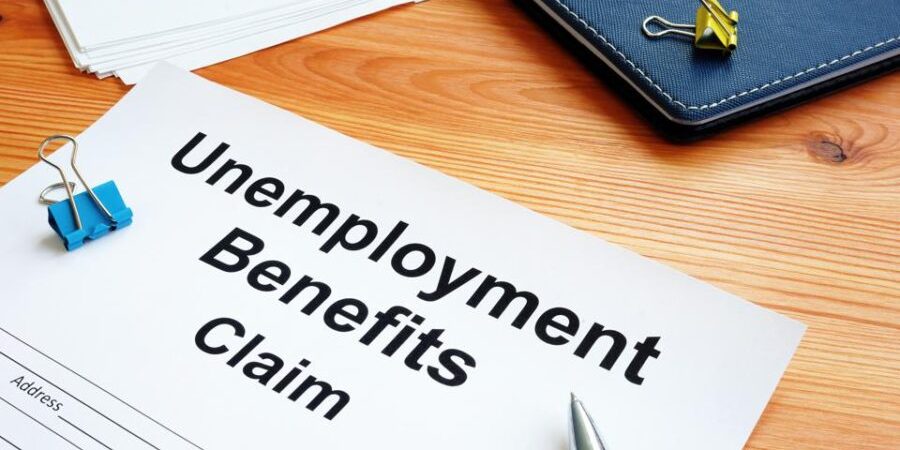A Guide to Unemployment Benefits: What You Need to Know
Unemployment benefits provide temporary financial help to workers who lose their jobs. These benefits support individuals while they search for new employment.
Losing a job can be stressful and challenging. Unemployment benefits aim to ease this burden by offering financial aid. They can help cover basic needs such as food, rent, and utilities. The goal is to provide a safety net during tough times.
Understanding how to apply for these benefits, the eligibility criteria, and the duration of assistance is crucial. This knowledge can help you navigate the process smoothly and ensure you receive the support you need. Let’s explore the essentials of unemployment benefits and how they can assist you during periods of joblessness.
:max_bytes(150000):strip_icc()/how-to-calculate-your-unemployment-benefits-2064179-v2-5bb27c7646e0fb0026d9374f.png)
Credit: www.thebalancemoney.com
Types Of Unemployment Benefits
Unemployment benefits come in various forms. They help individuals who have lost their jobs without their fault. Understanding the types of benefits available can ease financial burdens. These benefits are divided into federal programs, state programs, and emergency benefits. Each has unique features and eligibility requirements.
Federal Programs
Federal programs provide a safety net for unemployed individuals across the United States. These benefits are funded by the federal government. They are designed to support a broad range of workers.
Here are some key federal unemployment programs:
- Unemployment Insurance (UI): This is the main program. It offers temporary financial assistance to eligible workers. The amount and duration depend on the worker’s previous earnings and state laws.
- Disaster Unemployment Assistance (DUA): This program helps people who lose their jobs due to a disaster. It provides financial assistance to those not covered by regular unemployment insurance.
- Trade Adjustment Assistance (TAA): This helps workers who lost their jobs due to foreign trade. It offers job training, income support, and job search allowances.
Federal programs aim to provide a safety net during economic hardships. They ensure that workers have a source of income while seeking new employment.
State Programs
State programs offer unemployment benefits tailored to the residents of each state. These programs are funded by state taxes and are managed by state labor departments.
Key features of state programs include:
- Eligibility Requirements: Each state has specific eligibility criteria. These include the amount of wages earned and the reason for unemployment.
- Benefit Amounts: The weekly benefit amount varies by state. It is usually a percentage of the worker’s previous earnings.
- Duration of Benefits: The duration of benefits also varies. Most states offer benefits for up to 26 weeks. Some states may offer extended benefits during high unemployment periods.
The table below shows an example of state program variations:
| State | Weekly Benefit Amount | Maximum Duration (weeks) |
|---|---|---|
| California | $450 | 26 |
| New York | $504 | 26 |
| Texas | $521 | 26 |
Understanding state programs can help individuals maximize their benefits. It is important to check the specific requirements and benefits of your state.
Emergency Benefits
Emergency benefits come into play during times of crisis. These programs provide additional support when regular unemployment benefits are not enough.
Examples of emergency benefits include:
- Emergency Unemployment Compensation (EUC): This program extends benefits when unemployment is high. It provides additional weeks of benefits to those who have exhausted their regular benefits.
- Pandemic Unemployment Assistance (PUA): This was introduced during the COVID-19 pandemic. It provided benefits to self-employed workers and others not usually eligible for unemployment benefits.
- Federal Pandemic Unemployment Compensation (FPUC): This program provided an extra weekly payment to unemployed individuals. It aimed to help those affected by the pandemic’s economic impact.
Emergency benefits are crucial during economic downturns. They ensure that individuals have financial support when they need it the most.
Eligibility Criteria
Unemployment benefits provide financial help for workers who lose their jobs through no fault of their own. To qualify, individuals must meet certain eligibility criteria. Understanding these criteria helps in determining if one can apply for the benefits. This section will discuss the key eligibility criteria which include work history, income limits, and job search requirements.
Work History
To be eligible for unemployment benefits, a person’s work history is crucial. States require a minimum amount of work or earnings over a base period. This period usually spans about a year. Here are some key points to consider:
- Base Period: Typically, the first four of the last five completed calendar quarters before filing for benefits.
- Minimum Earnings: Many states have a minimum earnings threshold. For instance, you might need to have earned at least $3,000 during the base period.
- Employment Duration: Some states require individuals to have worked for at least two quarters during the base period.
Here is a table illustrating an example of how the base period works:
| Quarter | Duration |
|---|---|
| First Quarter | January – March |
| Second Quarter | April – June |
| Third Quarter | July – September |
| Fourth Quarter | October – December |
Understanding your work history can help you determine if you meet the criteria for unemployment benefits.
Income Limits
Income limits are another crucial factor in determining eligibility for unemployment benefits. Each state sets its own income limits. Here are some important aspects to consider:
- Earnings: Your earnings during the base period must meet the state’s minimum threshold.
- Part-time Work: If you are working part-time, your earnings may affect your benefit amount. States have specific guidelines for this.
In some cases, the income limits are designed to ensure that those who need help the most receive it. Check with your state’s unemployment office to understand the specific income limits. Here is a simple example:
| State | Minimum Earnings Requirement |
|---|---|
| California | $1,300 in one quarter |
| New York | $2,400 in one quarter |
Knowing the income limits can help you prepare your application and understand your eligibility.
Job Search Requirements
Active job search is often a key requirement for receiving unemployment benefits. States expect beneficiaries to be actively looking for work. Here are some common job search requirements:
- Number of Job Applications: Many states require you to apply for a certain number of jobs each week.
- Record Keeping: Keep a record of your job search activities. This includes the jobs you applied for, the dates, and any follow-up actions.
- Job Search Workshops: Some states require attendance at job search workshops or career counseling sessions.
Meeting these job search requirements is crucial. It demonstrates that you are actively seeking employment. Here is an example of a weekly job search record:
| Date | Company | Position | Application Method |
|---|---|---|---|
| 01/10/2023 | ABC Corp | Sales Associate | Online |
| 01/11/2023 | XYZ Inc | Customer Service |
Understanding and meeting the job search requirements can help you maintain your eligibility for unemployment benefits.
Application Process
Applying for unemployment benefits can seem daunting, but understanding the process can help. This guide breaks down the application process into easy steps. Learn about online applications, in-person resources, and the required documentation.
Online Applications
Filing for unemployment benefits online is convenient and quick. Most states have dedicated websites for this purpose. Here’s what you need to know:
- Website Access: Visit your state’s unemployment benefits website.
- Create an Account: Register for an account with your personal details.
- Fill Out the Application: Complete the online form with accurate information.
- Submit Your Application: Review your details and submit the application.
Many websites offer tutorials and FAQs to help you through the process. Some states even have mobile apps for filing applications, making the process even more accessible. Here is a quick reference table:
| State | Website | Mobile App |
|---|---|---|
| California | edd.ca.gov | Yes |
| New York | labor.ny.gov | No |
In-person Resources
Not everyone is comfortable with online applications. For those who prefer face-to-face assistance, in-person resources are available. Many states have local unemployment offices where staff can help you with your application. Here’s what you can do:
- Find Your Local Office: Use your state’s website to locate the nearest unemployment office.
- Visit During Office Hours: Check the office hours before visiting. Some offices may require an appointment.
- Bring Necessary Documents: Carry all required documents to ensure your application is processed quickly.
Staff at these offices can guide you through the application process, answer your questions, and help resolve any issues. They may also provide additional resources such as job search assistance and training programs.
Required Documentation
Before starting your application, gather the necessary documents. Having these ready will make the process smoother. Here’s what you typically need:
- Personal Identification: Driver’s license or state ID card.
- Social Security Number: Ensure you have your SSN handy.
- Employment History: Details of your last employer, including name, address, and contact information.
- Reason for Unemployment: Documentation explaining why you are unemployed.
Additionally, some states may require:
- Proof of income, such as recent pay stubs.
- Bank account details for direct deposit.
Having these documents ready will speed up the application process and reduce the chances of delays. Ensure all information is accurate and up-to-date to avoid any issues.

Credit: clsphila.org
Duration Of Benefits
Understanding the duration of unemployment benefits is crucial for anyone who finds themselves out of work. These benefits provide temporary financial assistance, helping individuals cover basic needs while they search for new employment. The duration can vary based on several factors, including state regulations and economic conditions. Let’s explore the different aspects of how long you can receive unemployment benefits.
Standard Periods
The standard period for unemployment benefits can differ from state to state. Most states offer up to 26 weeks of benefits. This period is designed to give individuals ample time to find new employment.
Here are some key points about the standard periods:
- Most states offer benefits for up to 26 weeks.
- Some states may offer fewer weeks based on their specific regulations.
- The amount of benefits received each week is usually a percentage of your previous earnings.
Here’s a table showing a few examples:
| State | Standard Duration (Weeks) |
|---|---|
| California | 26 |
| Florida | 12 |
| New York | 26 |
Extensions
Sometimes, the standard period of benefits is not enough, especially during economic downturns. In such cases, the government may offer extensions. These extensions can provide additional weeks of benefits.
Important points to consider:
- Extended benefits are usually triggered by high unemployment rates.
- The amount of extended benefits can vary.
- You may need to apply separately for extended benefits.
There are different types of extensions:
- Emergency Unemployment Compensation (EUC): Offered during severe economic crises.
- Extended Benefits (EB): Triggered by high state unemployment rates.
Reapplication Process
If your benefits run out, you may need to reapply. The reapplication process can be straightforward but requires careful attention to detail.
Here are steps to follow:
- Check your eligibility: Ensure you still qualify for benefits.
- Gather necessary documents: Have your previous employment information ready.
- Submit a new application: Follow your state’s process for reapplication.
Some important tips:
- Keep track of deadlines: Missing a deadline can delay your benefits.
- Stay informed: Regulations can change, so stay updated with your state’s unemployment office.
- Seek assistance: If you’re unsure, contact your state’s unemployment office for help.
Understanding these aspects of unemployment benefits can help you navigate the system more effectively. Stay informed and proactive to ensure you receive the support you need during your job search.
Impact On Job Seekers
Unemployment benefits provide essential support to job seekers. These benefits impact their financial stability, job search motivation, and skills development. Understanding these impacts helps appreciate the role of unemployment benefits in society.
Financial Support
Unemployment benefits offer crucial financial assistance to job seekers. This support helps them cover basic living expenses while searching for new employment opportunities. Here are some key points:
- Basic Necessities: These benefits help individuals pay for rent, utilities, and groceries.
- Healthcare: They may also assist with healthcare costs, ensuring job seekers remain healthy.
- Debt Management: Financial support helps manage debts and avoid further financial strain.
Consider the following table illustrating the average monthly expenses covered by unemployment benefits:
| Expense | Average Cost |
|---|---|
| Rent | $800 |
| Utilities | $150 |
| Groceries | $300 |
| Healthcare | $200 |
Unemployment benefits provide a financial cushion. This support reduces stress and allows job seekers to focus on finding suitable employment.
Job Search Motivation
Unemployment benefits can impact a job seeker’s motivation. While financial support is essential, benefits also encourage active job searching. Here are some ways benefits influence motivation:
- Time Allocation: Benefits provide financial relief, allowing job seekers to dedicate more time to job hunting.
- Job Match: With financial support, job seekers can focus on finding jobs that match their skills and interests.
- Networking: Benefits enable job seekers to attend job fairs and networking events.
Unemployment benefits often come with requirements:
- Regular job search activities
- Applying for a certain number of jobs weekly
- Attending job search workshops
These requirements ensure that job seekers stay motivated and actively pursue employment opportunities. Benefits act as both support and incentive.
Skills Development
Unemployment benefits also play a role in skills development. Job seekers can use this time to improve their skills and increase employability. Here are some ways benefits support skills development:
- Training Programs: Many unemployment programs offer access to vocational training.
- Online Courses: Job seekers can take free or low-cost online courses.
- Workshops: Attending workshops on resume writing, interview skills, and more.
Here is a list of common skills development opportunities:
| Skill | Development Method |
|---|---|
| Computer Skills | Online courses |
| Communication | Workshops |
| Technical Skills | Vocational training |
By focusing on skills development, job seekers increase their chances of finding suitable employment. Unemployment benefits thus offer a comprehensive support system, helping individuals improve their prospects.
Tax Implications
Unemployment benefits provide crucial support for individuals who have lost their jobs. While these benefits help cover essential expenses, they come with important tax implications. Understanding these implications can help manage your finances better and avoid any surprises at tax time.
Taxable Income
Unemployment benefits are considered taxable income. This means you must report them on your federal tax return. The IRS requires you to include these benefits as part of your gross income.
Here are key points to remember:
- Unemployment benefits are subject to federal income tax.
- You may choose to have federal taxes withheld from your benefits.
- The withholding rate is typically 10% of the benefit amount.
Below is a table showing an example of how tax withholding might work:
| Weekly Benefit Amount | Tax Withheld (10%) | Net Benefit Amount |
|---|---|---|
| $400 | $40 | $360 |
| $500 | $50 | $450 |
Choosing to withhold taxes can prevent a large tax bill at the end of the year. If you decide not to withhold taxes, you might need to make estimated tax payments to avoid penalties.
Reporting Requirements
When filing your taxes, you must report your unemployment benefits. The state unemployment office will send you Form 1099-G, which details the amount of benefits you received.
Here’s what you need to do:
- Receive Form 1099-G from your state unemployment office.
- Check that the information on the form is correct.
- Include the total amount from Form 1099-G on your federal tax return.
If you received unemployment benefits from multiple states, you will get a 1099-G from each state. Ensure you report the total amount accurately.
Here is an example of how to report the income:
- Form 1099-G shows $5,000 in unemployment benefits.
- Include this amount on Line 7 of Form 1040.
Accurate reporting helps avoid any issues with the IRS. Keep all documents and records in case you need them for reference.
State Variations
States have different rules for taxing unemployment benefits. Some states tax these benefits, while others do not.
Here are some examples:
- California does not tax unemployment benefits.
- New York taxes unemployment benefits.
- Florida does not have a state income tax, so no tax on benefits.
Check your state’s tax rules to understand your obligations. The table below shows a few states and their tax rules:
| State | Tax on Unemployment Benefits |
|---|---|
| California | No |
| New York | Yes |
| Florida | No |
Knowing your state’s rules can help you plan better. Some states offer additional resources to help you understand their tax requirements.
Understanding these tax implications can help you manage your finances effectively. Be sure to stay informed and prepared.
Common Challenges
Unemployment benefits provide essential support for those who have lost their jobs. Despite their importance, many people face common challenges while accessing these benefits. Understanding these obstacles can help individuals navigate the system more efficiently.
Fraud Risks
One major challenge is the risk of fraud. Fraudulent claims drain resources and delay benefits for those truly in need. Here are some common fraud risks:
- Identity theft: Criminals use stolen identities to claim benefits.
- False employment information: Claimants provide incorrect job loss details.
- Overstated earnings: Individuals exaggerate previous earnings to receive higher benefits.
Government agencies work hard to detect and prevent fraud. They use advanced technology to verify identities and cross-check information. Despite these efforts, fraud remains a significant issue.
Fraud not only affects the system but also impacts genuine claimants. Legitimate applicants may face delays or denials due to fraudulent activities. This creates frustration and hardship for those who depend on unemployment benefits.
Here are some tips to avoid becoming a victim of unemployment benefit fraud:
- Protect personal information. Use strong passwords and secure websites.
- Monitor credit reports for unusual activity.
- Report suspicious activities to the authorities.
Delays In Processing
Another challenge is delays in processing claims. Many factors contribute to these delays:
- High volume of applications: Economic downturns increase the number of claims.
- Administrative backlog: Understaffed agencies struggle to keep up.
- Incomplete applications: Missing information slows down the process.
Delays can cause financial strain for claimants waiting for benefits. To reduce delays, applicants should:
- Submit complete and accurate information.
- Follow up regularly with the unemployment office.
- Keep records of all communications and documents.
A table summarizing common causes of delays and solutions:
| Cause of Delay | Solution |
|---|---|
| High volume of applications | Be patient, check status regularly |
| Administrative backlog | Contact the office for updates |
| Incomplete applications | Double-check information before submission |
Appealing Decisions
Sometimes, claims are denied. This leads to the need for an appeal. The appeal process can be complex and time-consuming. Here are some common reasons for denial:
- Insufficient earnings: Claimant did not earn enough before unemployment.
- Misconduct: Job loss due to employee’s fault.
- Incorrect information: Errors in the application.
To appeal a decision, follow these steps:
- Review the denial notice carefully. Understand the reason for denial.
- Gather supporting documents. This may include pay stubs, termination letters, and any other relevant evidence.
- Submit the appeal within the specified timeframe. Missing the deadline may result in losing the right to appeal.
The appeal process may involve a hearing. Here are some tips to prepare:
- Be honest and clear in your statements.
- Present all relevant documents and evidence.
- Consider seeking legal advice if needed.
Understanding these common challenges helps individuals better navigate the unemployment benefits system. By being aware of fraud risks, processing delays, and the appeals process, claimants can take proactive steps to ensure they receive the support they need.
Future Of Unemployment Benefits
Unemployment benefits are vital for many who lose their jobs. These benefits help people pay bills and buy food. But what will the future of unemployment benefits look like? Changes are coming in policies, the gig economy, and universal basic income. Let’s explore these changes.
Policy Changes
Policy changes will shape the future of unemployment benefits. Governments may update rules to better fit the modern job market. Here are some potential changes:
- Duration of Benefits: Some areas might extend how long people can receive benefits. Others may shorten it.
- Eligibility Criteria: Rules for who qualifies may change. This can include part-time workers or those in temporary jobs.
- Benefit Amounts: The money given might increase or decrease. It could adjust based on the cost of living.
These changes can have a big impact. They might help more people or make it harder to get help. Policymakers must consider the needs of the jobless and the economy. A balance is needed.
Gig Economy Implications
The gig economy is growing fast. Many people now work as freelancers or on short-term contracts. This change affects unemployment benefits:
- Inconsistent Work: Gig workers may not have steady income. This makes it hard to fit into traditional benefit systems.
- Lack of Benefits: Most gig jobs do not offer health insurance or retirement plans. This puts more pressure on unemployment benefits.
- New Rules: Some areas are creating new rules to help gig workers. This might include special unemployment benefits.
Governments must adapt to these changes. Supporting gig workers is important. New policies can provide a safety net for these workers.
Universal Basic Income
Universal Basic Income (UBI) is another idea. UBI means giving everyone a set amount of money each month. This could replace or add to unemployment benefits. Here are some points to consider:
- Consistent Support: UBI provides regular income for all. This helps people who lose jobs and those in low-paying work.
- Reduced Stress: Knowing you have a steady income can reduce stress. This can improve mental health and overall well-being.
- Economic Impact: UBI can boost the economy. People with money to spend can help local businesses.
UBI is a big change. It requires careful planning and funding. Some places are testing UBI programs. The results will show if this is a good option for the future.

Credit: www.jobsanddevelopment.org
Frequently Asked Questions
How Much Does Texas Unemployment Pay?
Texas unemployment benefits range from $70 to $563 per week. The exact amount depends on your previous earnings.
Is Unemployment $600 A Week?
Unemployment benefits vary by state and situation. During COVID-19, an additional $600 per week was available temporarily. Check current benefits with your state agency.
How Much Do You Get Paid For Unemployment In Utah?
In Utah, unemployment benefits range from $31 to $712 per week. The amount depends on your previous earnings.
What Disqualifies You For Unemployment In Texas?
In Texas, disqualification for unemployment occurs if you quit voluntarily, were fired for misconduct, refuse suitable work, or fail to meet work search requirements.
Conclusion
Unemployment benefits provide crucial support during challenging times. They help individuals cover basic needs. Applying for these benefits can ease financial stress. Stay informed about eligibility requirements. Timely applications ensure you receive the help you need. Benefits vary by location, so check local guidelines.
Understanding your rights is essential. Seek assistance if you face difficulties. Properly managed, these benefits offer relief. They enable stability and peace of mind. Use available resources wisely for maximum benefit. Remember, help is available when needed. Stay positive and proactive in your search for employment.



